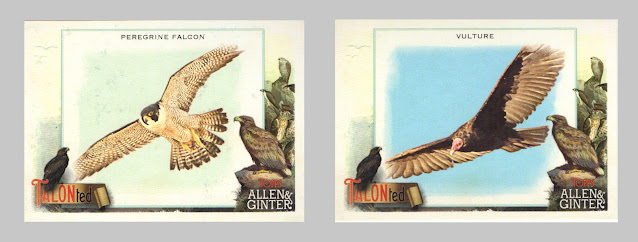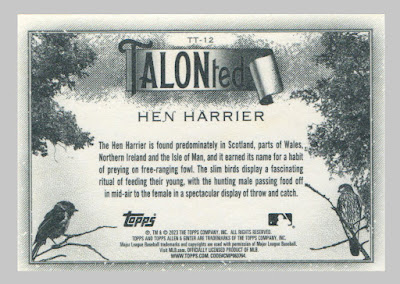Quick story:
About 11 or 12 years ago, when I was living in the Lower Hudson Valley, I'd commute into Manhattan for work on the Metro-North railroad. My home station was one of the local stops that was situated right on the river, which provided some outstanding views from the platform. And beside the railroad station was an old, abandoned electric generating plant of some sort. Attached to the plant were two brick smokestacks that rose high into the sky. The building became my mysterious little friend for many years.
Well, one morning while waiting for the train, I heard some distinct bird cries from way up on top of the smokestacks. It sounded like a bird of prey much more than a songbird of any kind. I looked up, but couldn't make anything out before the train arrived. Over the next week or so, I'd often hear the same sounds in the morning. My best guess was that a pair of hawks or falcons (or eagles?!) had nested up there, and I was hearing either their little chick or one of the two adults. My hypothesis was confirmed soon enough, because one day I looked up there, and saw this:
Peregrine falcons! Here's another view of one of them.
This was a pretty cool sighting. Peregrines are no longer on the Federal endangered list, but they do remain endangered in New York State. At the time, I remember being so taken aback by the sighting that I found the phone number of a regional wildlife office, just so I could call and report that a pair of falcons had likely nested up there. Impressively, the person I spoke with mentioned that the nesting pair on that specific tower had already been reported and confirmed by others, and that the wildlife department was investigating.
It's years later now, and I couldn't tell you what happened to that nesting pair, or how long they made their home on the smokestack. Regardless, it was a pretty cool experience.
I suppose at this point it'd be no surprise to any of you that I'm a bird-watcher. It's not a new hobby, either. I'd say it goes back to my early childhood, when my dad showed me a field guide to the birds of the northeast. (Lots of detailed information and full-color illustrations inside.)
It's been a casual yet continual activity ever since. Birds are pretty remarkable creatures. When out for a walk, waiting for the train, or anywhere else, it can be fun to keep an eye and an ear open—not only for birds in flight, but also for songs and calls.
I no longer have that original field guide, but my current version sports a little removable Post-It flag on each page that contains a bird I've seen in the wild.
So what in the world does all this have to do with trading cards?
Well, 2023's Allen & Ginter baseball release contained an insert set called "TALONted". Within it were 20 different birds of prey. Seeing a couple of the cards online was enough for me to want to collect the full set. (It would be my first completed A&G insert set since I finished acquiring all 10 Magnificent Moons cards back in 2019.)
And although I could have picked up the whole shebang on eBay for an affordable price, I wanted to do it the old-fashioned way: Through trades. It's just much more fun that way. Plus, by trading, I'm able to help a few fellow collectors out with some of their card needs.
So after a handful of trades, I'm happy to report that I've got the entire set now. Because it's only 20 cards deep, I'm going to share all of them here, two by two.
Let's go.
Ospreys often make their nests near water sources, as their main source of food is fish. (Nice photo on the card!) As for the Andean condor, its wingspan can reach up to 10.5 feet. I can only imagine what it would be like to see one up close with its wings spread out.
There's the peregrine falcon on the left. Falconry is still a big thing in parts of the world. A few years ago I actually had the chance to have a trained falcon perch on my arm for a few seconds. Very cool experience. The back of the vulture's card mentions that a group of vultures is called a "kettle".
When I took the aforementioned commuter train up and down the Hudson River into Manhattan for work, I'd occasionally see a bald eagle or two soaring above the river. I'd even see them from my home. They really are a sight to behold, and I'm happy they've made a bit of a comeback over the past 10 or 15 years. As for buzzards, the actual bird looks quite different from that dopey character who's featured in a few bugs bunny cartoons.
The great horned owl can be found in many habitats across the US. That classic "hoo-hoo-hoo" that you hear in so many TV shows and films? That's the great horned owl. The snowy owl's range is mostly farther north (i.e., Canada and the Arctic), but they can sometimes be spotted in the US. Interestingly, and unlike most owls, they are diurnal.
The golden eagle always reminds me of a song of the same name by a musician named John Shannon. Looks like he's about to grab some lunch on that card image. The merlin is one of the smaller birds of prey, but it's very fast and sneaky. The card back mentions that merlins were used for sport by medieval noblewomen, including Catherine the Great and Mary queen of Scots.
We'll we're halfway through, and you might have noticed that there doesn't seem to be a rhyme or reason in the order of the cards. They're not arranged in alphabetical order, or by species. That's totally fine with me. I think it's probably better that it's random. As for the images, most of them show the birds in flight, or with their
talons out, ready to try to grab their prey. I do appreciate the colors used and the somewhat artistic look of the images, as well.
Write-ups
are nicely done, as they often are with
A&G insert sets. All of the fine print is kept decently out of the way at the bottom of the card, which is good.
Back to the set now.
The secretary bird can be found in Africa. Their genus and species name, Sagittarius serpentarius, means "archer of snakes", because the bird is known for hunting snakes. The hen harrier is found around Scotland, Wales, and Northern Ireland, and received its name because it is known to hunt on free-ranging fowl.
Sparrowhawks are common across the United Kingdom, and are ambush hunters. As the name suggests, they often hunt smaller birds. The red kite is found across Europe, and can be spotted by their reddish color and forked tail. Along with hunting, they're known to scavenge for meals.
Gyrfalcons have a similar habitat to the snowy owl, and are the largest of the falcon family. The barn owl has a more creepy-looking face than other owls. The shape actually helps its impressive hearing abilities. Barn owls are known to nest in human-built structures like barn lofts, hence the name.
The California condor is native to the Western US. They're scavengers that are capable of flying long distances in a day in search of food. The seriema is native to South America, and with those long legs it's no surprise that they run around on the ground as much as they fly.
The harrier can be found throughout the US and Canada, and hunt all sorts of small animals. Interestingly, they're one of the types of birds that nest on the ground, in heavy patches of vegetation. Red-tailed hawks are pretty common in many areas of the US, and can be spotted by their rusty-red tails.
And that's the set.
Now here's a checklist of TALONted birds I've actually seen in the wild:
Bald Eagle
Osprey
Peregrine Falcon
Red-Tailed Hawk
I've heard what sounds like a great horned owl near the house, early in the morning, but I don't think I've ever actually seen one. I'll have to start going out for the occasional early-morning or late-night walk. I guess 4 out of 20 isn't bad, especially considering that some of the birds on the checklist aren't native to my region of the US, or the US at all.
Jon Pennysleeves, you've got a lot of nature around the homestead. Any interesting bird sightings?
Fuji, have you ever seen a California Condor? They're on the endangered list, but they've been making a bit of a comeback.
If any of you readers have a bird story or two, share in the comment section.
Thanks for reading!














I'm 7 for 20 in seeing these birds in the wild. I live within a nice walk of the James River so bald eagles are one of the most common sightings from this list. A bird story: Usually the eagles stick to the areas immediately next to the water catching fish, but they occasionally look for a meal closer to my place. They are very opportunistic, and two weeks ago a young eagle (no white head yet) spotted a vulture that had found a meal on my street. It swooped in, stole whatever the vulture had been eating, and took it up to a nearby rooftop. The vulture followed but kept its distance as the eagle turned to face it before finishing off the meal. All in, this was a rather exciting sight for me to see on a random trip to the mailbox.
ReplyDeleteGreat story, CB! Thanks very much for sharing it here. That juvenile eagle wasn't messing around.
DeleteHmmm... I might have seen a California Condor. I've definitely seen some large birds on camping trips and hikes over the years, but honestly couldn't tell you what kind of birds they were. By the way... great post. I love how you tied this set to a part of your personal timeline. I enjoy collecting the exact same way and could see myself doing something like this too (had I come across a family of peregrine falcons).
ReplyDeleteThanks very much, Fuji! (As for the similar way we collect, I'm trying to resist making a "birds of a feather" statement here...)
DeleteCool little set. I've seen a few of these birds in the wild, including the Great Horned and Snowy Owls. And Bald Eagles are pretty darn big. I had one buzz by me when I was riding my lawn tractor and I could hear the flap of its wings over the running motor.
ReplyDeleteThat's an impressive experience, Crocodile! Sometimes I tune in to a livestream of an eagle's nest and watch as they raise their young over the course of the year. It's hard to tell just how big the nest and the young eagles are, but they're impressive for sure.
DeleteHappy completed set! I don't consider myself a bird watcher per se, but do pay plenty of attention to them just like I do with every other nature-y thing that I encounter. Because of this, I have acquired plenty of observations and "stories" over the years that, given the opportunity, I'm sure that I could bore someone to death with.
ReplyDeleteNot boring, my friend! I think quite a few readers have enjoyed the nature stories on your blog over the years.
Delete